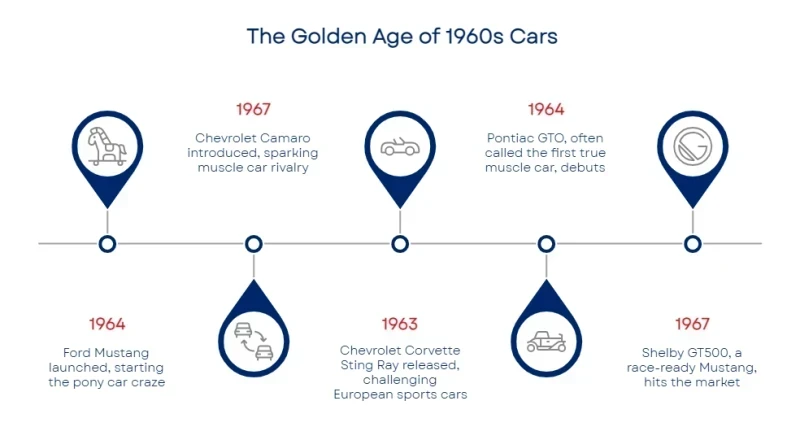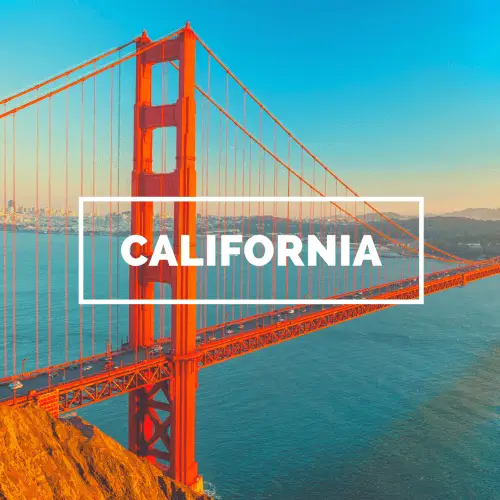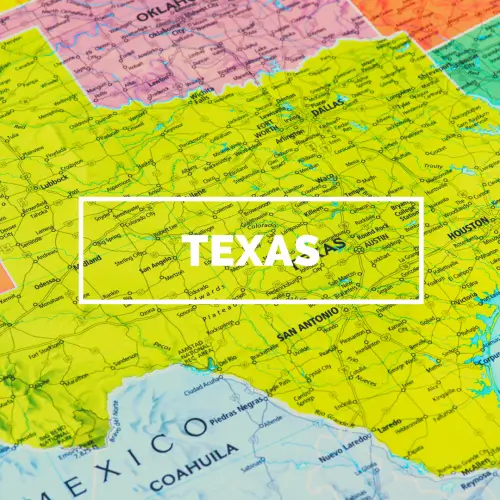The Golden Age of Power, Personality, and Performance
Cruising down a wide-open highway in a 1965 Ford Mustang, wind in your hair, and the rumble of a V8 under the hood, that’s what 1960s cars were all about. These weren’t just vehicles. They were power, personality, and pride all rolled into one steel body.
From muscle cars that roared to life at stoplights to compact rides that squeezed into every driveway, this decade gave us some of the most unforgettable models in automotive history. If you’ve ever wondered why these cars still pull crowds at shows and break records at auctions, you’re in the right place.
The '60s weren’t quiet. They weren’t dull. And neither were the cars. In this post, we’ll take a trip back in time to explore what made these machines legends on the road and why their stories still resonate today.
What You’ll Learn
In this post, you’ll see:
Which 1960s cars became the most popular, and why they stood out
What made these models so loved
Which classics are now considered collector's gold, and what drives their value higher every year
Overview: What Made These Cars the Stars of the 1960s
The 1960s gave us more than just fast engines and flashy paint. It was an era when cars embodied personal freedom, reflected changing styles, and introduced new ideas about speed and design. What became popular back then still shapes how we think about cars today. Whether you care about performance, history, or looks, the decade offered something for everyone.
Here's a more detailed breakdown:
Everyday Legends: Cars That Ruled the Roads
These models weren’t reserved for car collectors. They were the daily drivers of the decade, renowned for their blend of style, performance, and affordability.
Ford Mustang (1964): Sparked the pony car craze with sporty looks and affordable V8 power.
Volkswagen Beetle: Beloved for its durability and unique design. Sold millions around the world.
Chevrolet Camaro (1967): GM’s answer to the Mustang, sparking a muscle car rivalry.
Muscle and Speed: The Performance Icons
Built to go fast and look good doing it, these cars set the standard for American horsepower.
Pontiac GTO: Often called the first actual muscle car. Bold design and powerful V8s.
Chevrolet Corvette Sting Ray (1963): A rival to European sports cars with advanced design.
Shelby GT500 (1967): A race-ready Mustang tuned for high performance.
Global Influence: Cars That Made Their Mark Worldwide
These cars helped shape car culture far beyond the United States.
Jaguar E-Type: Sleek and fast, praised even by Ferrari’s founder.
Ferrari 250 GTO (1962): One of the most expensive and admired classics today.
Luxury and Style: American Comfort on Four Wheels
These models demonstrated the extent to which design and comfort could be combined, seamlessly blending luxury with presence.
Buick Riviera: Smooth styling with power under the hood.
Chevrolet Impala: Flashy and full-sized, perfect for long family drives.
Other Notable Models of the Decade
A few more fan favorites are worth mentioning for their reliability, design, or unique appeal.
Ford Falcon and Plymouth Valiant: Solid compact options during the rise of economy cars.
Volvo P1800: Gained popularity through TV and offered sleek European style.
Lincoln Continental: Famous for its slab-sided look and rear-hinged doors.
What Made the 1960s the Golden Age of Cars
The 1960s revolutionized the way people viewed cars. They were no longer just tools for getting around. They became symbols of identity, freedom, and personal style. That shift helped launch the most memorable models of the era.
American automakers pushed limits: muscle cars packed more power, interiors got more comfortable, and design took bold leaps with chrome, curves, and low stances. Foreign brands brought efficiency and style that contrasted sharply with Detroit’s excess, shaping a new global standard.
The design also moved forward. Cars shed the boxy look of the 1950s and adopted sleek lines, chrome accents, and low, wide stances. People didn’t just drive these cars. They showed them off. The mix of innovation, global pressure, and bold design made this decade one of the most exciting in car history.
The Models That Ruled the Roads and Rewrote the Rules
Some cars didn’t sell in large numbers. They shaped the way people saw driving, freedom, and fun. These models stood out for their exceptional performance, distinctive personalities, and significant impact on the car culture.
Quick Look: What Set These 1960s Icons Apart
Ford Mustang (1964)
The Mustang changed what a car could mean to the average driver. It offered something that felt custom-built for youth, speed, and style.
Started the pony car trend with a long hood and short rear deck
Gave buyers a sporty design with a budget-friendly price
Sold more than 618,000 units in its first year alone
Became a symbol of youth, freedom, and style
Chevrolet Camaro (1967)
GM’s bold reply to the Mustang sparked one of the most iconic rivalries in automotive history.
Offered style, speed, and rear-wheel power
Diverse engine options and trim levels
Became a staple of the muscle car movement
Volkswagen Beetle (1938)
With its rounded body and quiet confidence, the Beetle became the people’s car across continents. It was dependable, easy to love, and even easier to keep running.
One of the best-selling cars worldwide during the 1960s
A simple, air-cooled engine made it reliable and easy to fix
The iconic shape turned heads and offered something different
Affordable and popular across age groups and countries
Pontiac GTO (1964)
The GTO came out swinging with a bigger engine in a midsize body. It provided drivers with muscle car power without requiring them to spend muscle car money.
Called by many the first actual muscle car
Big V8 engine, bold styling, and loud attitude
Appeared in movies, music, and TV, growing its legend
Gave drivers raw speed and cool looks without a luxury price
Chevrolet Corvette Sting Ray (1963)
The Sting Ray wasn’t meant to blend in. With its sharp edges and fiberglass frame, it proved that American cars could challenge Europe’s best on both the track and the street.
A significant design shift with hidden headlights and sculpted body lines
Offered strong handling and speed with its V8 engine
Rivaled European sports cars in performance
It became one of the most collectible American cars ever built
Beyond the Engine: The Stories That Made These Cars Legendary
What turned a fast car into a cultural icon in the 1960s? It wasn’t just speed or looks. These cars showed up in music, movies, and memories. They gave people a sense of identity. They helped define what it meant to grow up, break free, and chase something bigger.
The youth movement and car freedom
Young drivers wanted something faster, louder, and unique. Driving meant independence.
Cars became a rite of passage.
Weekend cruising and street racing became a part of life.
New models were marketed directly to young buyers.
Innovation and affordability
The 1960s brought bold design and innovative engineering to everyday drivers.
Stronger engines were offered in lower trims
Compact and midsize cars added variety without significant costs
Design focused on both function and flair
TV and film influence
Hollywood didn’t just use cars as props. It turned them into characters.
The Mustang GT from Bullitt became an instant icon. Decades later, the original car sold at auction for $3.74 million, proving its lasting impact.
The Dodge Charger starred in The Dukes of Hazzard.
Even foreign models like the Volvo P1800 gained fame through shows like The Saint.
Final Thoughts
The 1960s changed what a car could mean. These cars weren’t just background details in a decade of change—they were part of the story. From highways to movie screens, they captured what people wanted: speed, style, and something they could call their own.
Decades later, these classics still carry that energy. They represent the feeling of turning the key and hearing something bigger than an engine, the start of a moment. Whether you grew up with one or dream of owning one, these cars still speak to the part of us that craves freedom and motion.
Ready to Ship a 1960s Classic?
Whether you’re buying, selling, or protecting a piece of car history, you want it moved safely. AmeriFreight Auto Transport has helped thousands transport classics like the Mustang, Corvette, and Impala across the country.
Our agents can walk you through every step and explain optional gap protection plans for extra peace of mind during transit.
Frequently Asked Questions (FAQs)
What engines were most common in 1960s American cars?
Most featured inline-6 or V8 engines, with V8s dominating the muscle car segment for their power and acceleration.
Why are 1960s cars still so popular with collectors?
They offer raw performance, bold design, and cultural impact, made before emissions and safety rules diluted the driving feel.
Were safety features standard in cars of the 1960s?
Not early on. Seatbelts became more common in the mid-20th century, but many safety standards were introduced later.
How fuel-efficient were 1960s cars?
Typically, 10–15 MPG for large V8s. Compact models, such as the Beetle, performed better but still lag behind modern efficiency standards.
Are 1960s cars hard to maintain?
They’re simpler mechanically than today’s cars, which makes them easier to work on for DIY owners. However, finding original parts can be tricky and costly, especially for rare models.
Which 1960s car has the longest production legacy?
The Ford Mustang. It is still being produced today, making it one of the longest-running nameplates in the history of American automotive production.
Disclaimer: This content is provided for general informational purposes only and should not be taken as legal, financial, or professional advice. AmeriFreight does not guarantee pricing, timing, or availability, and services are subject to change based on carrier availability and location constraints. Always consult a qualified professional for guidance specific to your situation.















